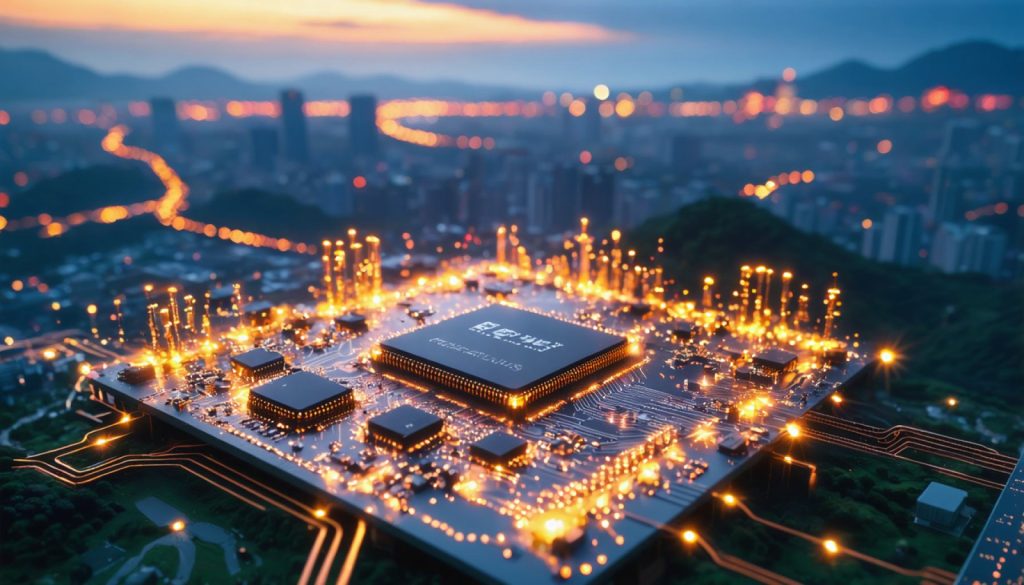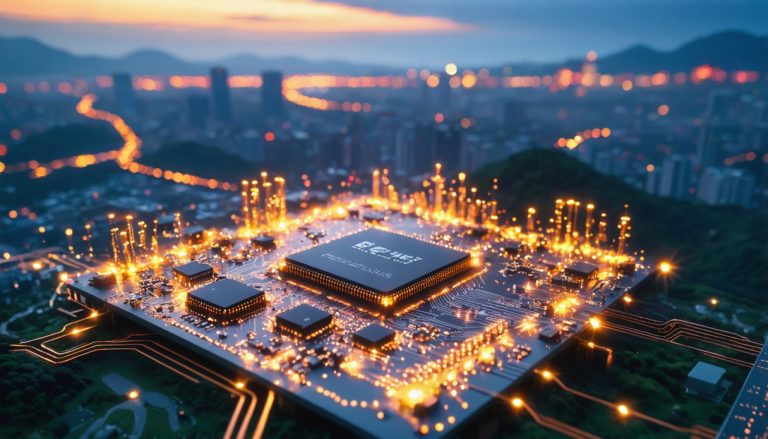
- China is transforming its semiconductor industry through strategic policies and high market demand, highlighted by HWATSING’s acquisition of Xinyu Semiconductor.
- HWATSING aims to dominate the ion implantation equipment market with complete ownership of Xinyu, enhancing its platform strategy.
- Mergers and acquisitions reflect China’s response to international relations, with innovation and expansion at the forefront.
- New equipment launches like NAURA’s Sirius MC 313 and Ausip T830 demonstrate advancements in ion implantation and electroplating technologies.
- The SEMICON China exhibition spotlighted breakthroughs from manufacturers like HWATSING and AMEC, attracting global attention.
- Products such as HWATSING’s iPUMA-LE highlight China’s leadership ambition in semiconductor solutions.
- Driven by strategic foresight, China’s semiconductor industry is poised to redefine global technology leadership.
As global tensions mold the landscape of technology, China is crafting a silent revolution within its semiconductor industry, propelled by a blend of astute policy maneuvers and insatiable market demand. The latest ripple in this quiet shift is HWATSING’s recent acquisition of Xinyu Semiconductor, a pivotal move delineating China’s strategic march into the high-end realm of semiconductor equipment.
HWATSING has firmly grasped Xinyu Semiconductor in its ambitious expansion plan, finalizing the purchase of a remaining 82% stake, culminating in complete ownership. With its sights set on dominating the ion implantation equipment market, HWATSING is leveraging this acquisition to solidify its platform strategy, intertwining advanced equipment capabilities with robust service offerings.
In the fabric of China’s semiconductor tapestry, mergers and acquisitions like HWATSING’s echo a larger narrative—one of urgency and ingenuity in response to complex international relations. By intricately navigating these waters, Chinese manufacturers are not merely expanding but redefining themselves. New equipment launches further punctuate this transformation, evidenced by NAURA’s Sirius MC 313 and Ausip T830, introducing innovative prowess into the ion implantation and electroplating realms.
The recently completed SEMICON China exhibition painted a vivid canvas of Chinese ingenuity, where manufacturers like HWATSING and AMEC unveiled cutting-edge advancements that magnetized global attention. With products like the iPUMA-LE high-current ion implantation machine, HWATSING is not just participating but shaping the narrative in advanced semiconductor solutions. These developments showcase a robust commitment to technology, underscoring the nation’s determination to not just participate but lead within the global semiconductor discourse.
Underneath the cloak of rapid innovation lies a palpable drive—a silent yet powerful testament to China’s strategic foresight. As HWATSING, NAURA, and others blaze trails across this domain, they illuminate China’s steadfast resolve to forge a path in semiconductor sovereignty. In a world where technology is king, China is subtly yet unmistakably ascending its throne, promising a future rich with possibility, and undeniably, challenges.
How China’s Semiconductor Revolution is Shaping the Future of Technology
As global tensions reshape the technology landscape, China is driving a silent revolution within its semiconductor industry, propelled by strategic policies and market demand. HWATSING’s recent acquisition of Xinyu Semiconductor is a pivotal move in the country’s strategic push into the high-end semiconductor equipment market.
Behind China’s Strategic Move in Semiconductors
1. HWATSING Acquisition and Market Impact: HWATSING’s acquisition of Xinyu Semiconductor is a critical step toward dominating the ion implantation equipment market. This acquisition consolidates HWATSING’s strategy to intertwine advanced equipment with robust service offerings, setting a foundation for long-term growth and innovation.
2. China’s Semiconductor Tapestry: This acquisition echoes the larger narrative of urgency and ingenuity in China’s response to complex international relations. China’s strategy involves intricate navigation of global tensions and technological advancements to redefine its position in the semiconductor industry.
3. Innovation Highlighted at SEMICON China: At the recent SEMICON China exhibition, manufacturers like HWATSING and AMEC showcased their emergence as industry leaders. HWATSING’s advanced iPUMA-LE high-current ion implantation machine is an example of this technological prowess, cementing China’s commitment to leading in advanced semiconductor solutions.
Real-World Use Cases and Industry Trends
– Ion Implantation Equipment: With increased demand in consumer electronics, automotive technologies, and artificial intelligence, ion implantation equipment is critical for advancing chip capabilities. HWATSING’s focus here reflects an alignment with global technology trends, which rely on superior chip manufacturing processes.
– Market Forecasts: The global semiconductor equipment market is expected to experience significant growth, with China emerging as a pivotal player. Industry analysts predict that China’s efforts in semiconductors could lead to increased global market share, reducing dependencies on other regions.
– Comparative Analysis: Comparing HWATSING’s technological advancements with competitors like Applied Materials and ASML highlights China’s rapid progression in adopting and enhancing semiconductor technologies.
Challenges and Limitations
– International Relations and Supply Chain: China’s semiconductor ambitions face challenges from international trade tensions and supply chain dependencies. Strategically, the country is investing in self-sufficiency and innovation to mitigate these risks.
– Technological Mastery: While China is advancing, the roadmap to semiconductor dominance involves mastering cutting-edge lithography and fabrication technologies, where it currently faces competitive disadvantages.
Pros & Cons Overview
Pros:
– Strategic acquisitions like HWATSING’s strengthen domestic capabilities.
– Advances in semiconductor technology support various high-demand sectors.
Cons:
– Political tensions could impact international collaborations.
– Continuing innovation demands significant investment and technical expertise.
Actionable Recommendations
– For Investors: Keep an eye on Chinese semiconductor companies like HWATSING for potential investment opportunities as they demonstrate remarkable growth and innovation.
– For Industry Professionals: Stay updated on China’s advancements in semiconductor technologies, which could offer new collaborative opportunities or competitive insights.
– For Policy Makers: Consider strategies that balance international trade relations with domestic innovation to sustain a leading position in the market.
By observing these developments, stakeholders worldwide can better understand and navigate the rapidly changing semiconductor landscape. For further insights on China’s technology innovations, visit SEMI China.
China’s trajectory in semiconductors promises a rich future with opportunities and challenges, where the combination of innovation, strategic foresight, and global collaboration will define success.



